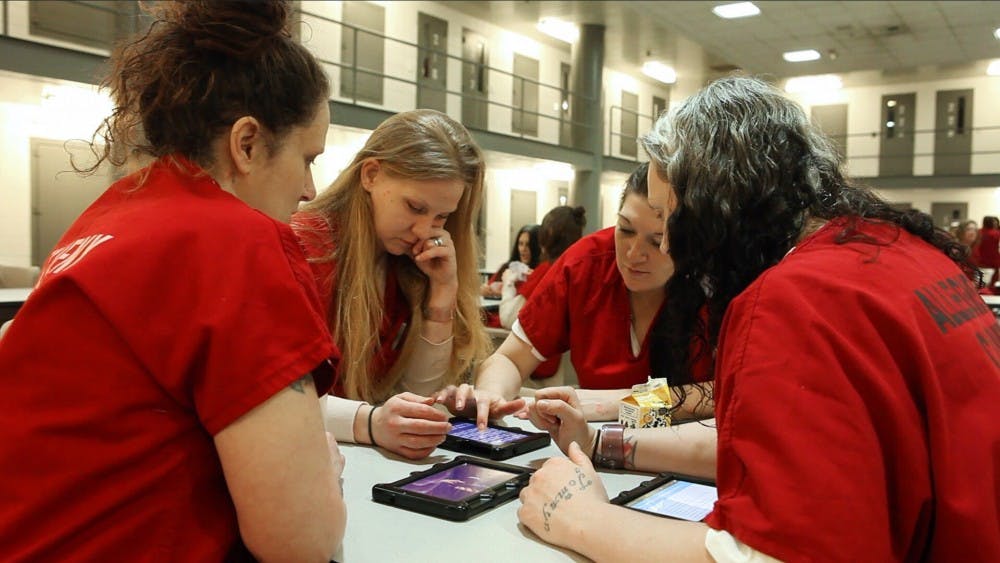Jennifer Doleac, Asst. Prof. of Public Policy and Economics in the Batten School, and Benjamin Castleman, Asst. Prof. of Education and Public Policy in the Education School, launched a new technology-based program to improve inmates’ transitions back into society and reduce levels of reincarceration. Coordinated efforts between a Chicago-based technology education company, Edovo, and University professors has led to the development of a tablet-based module. This module will be personalized to reduce levels of recidivism — or prisoner re-entry — and facilitate further work involving behavioral technology and justice policy.
“Prisoner re-entry is a major policy issue right now,” Doleac said. “We as a country are trying to find ways to reduce our dependence on mass incarceration. But at this point, the latest numbers indicate that two-thirds of those released from prison will be re-arrested in three years. Recidivism rates are extremely high, and that’s making it hard to reduce incarceration rates.”
To reduce reincarceration rates, researchers combine behavioral science with justice technology to customize programs that will help inmates effectively adjust back into society after being released.
Castleman, Doleac and researchers at Edovo are in the process of creating tablet-based modules that will guide inmates during their transitions. The tablet-based modules ask personal questions about family life, level of education and possible health conditions that will affect the forms of guidance that they will receive. Doleac coined the term “Turbotax for reentry” to describe the system that will allow for users to prioritize and organize their needs.
“The first part — when they’re using the module — will be, hopefully, in the two to four weeks before they’re released,” Doleac said. “And then after they’re let out, we will follow up with text messages to help them keep on track, and send reminders and nudges and additional information needed to help them stick to the plan they developed during that pre-release module.”
The Nudge4 Solutions Lab developed a text-message-based program to assist high school students in college application requirements. Castleman previously worked in the Education School’s Nudge4 Solutions Lab to help aid students as well as to show the benefits of technological innovation. Due to the system’s success, he believes a similar form of technology can be applied to inmate transitions. Castleman said he aims to employ a similar technique in creating a customized program to eventually lower rates of prison re-entry.
By considering the role of accountability and methods of information-processing, the program provides a possible method for not only lowering recidivism, but also spurring further developments in the field of justice policy.
According to Doleac, there is a broad spectrum of factors that contribute to high rates of recidivism, including difficulties acquiring health care, child care or educational opportunities. By linking former inmates to the proper resources, the new technology will mitigate the complications associated with transitioning to normal life and help to solve the central issue of housing and unemployment.
“Housing and employment are often thought of as if there’s a bit of a “chicken and egg” issue … It’s hard to get and keep a job and be a reliable employee who shows up at nine everyday if you don’t know where you’re sleeping that night,” Doleac said. “But it’s hard to get housing if you don’t have a way to pay for it, and advocates and practitioners will often say that housing and employment is a really crucial first step toward helping people get onto a stable path.”
Kevin Pujanauski from Edovo said in an email statement that the technology will allow for personalized transitions — helping users to overcome challenges associated with returning to a normal lifestyle. According to Pujanauski, Edovo’s goal is to provide hope to those who are incarcerated and recently released.
Pujanauski said he hopes that as evidence begins to show the program’s efficacy, Edovo can gain more funding and later expand the program to prisons in more than 15 states.
“Jails are often the main intercept point for people dealing with multiple traumas and socioeconomic disadvantages,” Pujanauski said. “Education and communication with loved ones have been shown to decrease recidivism among returning citizens, but these opportunities are severely limited for the average prisoner. With a set of people with nothing but time on their hands and the motivation to make changes in their lives, we are failing as a society at giving them resources to make those changes.”







